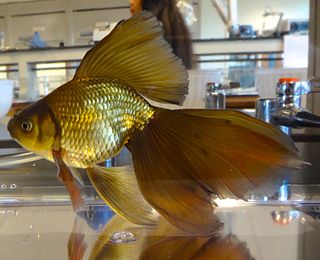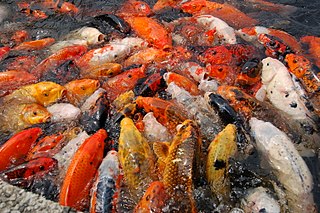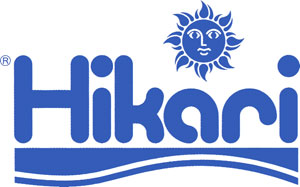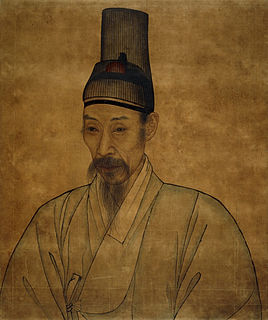

Koi magazine was launched by Origin Publishing in February 1999 as Koi, Ponds and Gardens and is published 13 times a year. The title changed to Koi in September 2004 to reflect its focus on Koi keeping. It is also the official magazine of the British Koi Keepers Society.

Koi or more specifically nishikigoi, are colored varieties of the Amur carp that are kept for decorative purposes in outdoor koi ponds or water gardens.

Koi... Mil Gaya, also known as KMG, is a 2003 Indian Hindi-language science fiction film directed and produced by Rakesh Roshan. It stars Hrithik Roshan and Preity Zinta, with Rekha in a supporting role. In addition to writing the story, Rakesh Roshan also wrote the screenplay with Sachin Bhowmick, Honey Irani, and Robin Bhatt. Koi... Mil Gaya focuses on Rohit, a developmentally disabled man who contacts an extraterrestrial being with his late father Sanjay's computer. The film follows his relationship with Nisha (Zinta), Rohit's friend, who falls in love with him.
KOI8-R is an 8-bit character encoding, derived from the KOI-8 encoding by the programmer Andrei Chernov in 1993 and designed to cover Russian, which uses a Cyrillic alphabet. KOI8-R was based on Russian Morse code, which was created from a phonetic version of Latin Morse code. As a result, Russian Cyrillic letters are in pseudo-Roman order rather than the normal Cyrillic alphabetical order. Although this may seem unnatural, if the 8th bit is stripped, the text is partially readable in ASCII and may convert to syntactically correct KOI7. For example, "Русский Текст" in KOI8-R becomes rUSSKIJ tEKST.
KOI8-U is an 8-bit character encoding, designed to cover Ukrainian, which uses a Cyrillic alphabet. It is based on KOI8-R, which covers Russian and Bulgarian, but replaces eight box drawing characters with four Ukrainian letters Ґ, Є, І, and Ї in both upper case and lower case.
KOI (КОИ) is a family of several code pages for the Cyrillic script. The name stands for Kod obmena informatsiey which means "Code for Information Interchange".

The comet or comet-tailed goldfish is a single-tailed goldfish bred in the United States. It is similar to the common goldfish, except slightly smaller and slimmer, and is mainly distinguished by its long deeply forked tail. Comet goldfish tend to have a diverse variety of colors, unlike the common goldfish.

The veiltail is a type of goldfish known for its extra-long, flowing double tail and high sail-like dorsal fin.

Koi ponds are ponds used for holding koi carp, usually as part of a garden. Koi ponds can be designed specifically to promote health and growth of the Nishikigoi or Japanese Ornamental Carp. Koi ponds or lakes are a traditional feature of Japanese gardens, but many hobbyists use special ponds in small locations, with no attempt to suggest a natural landscape feature.
Cheryl Mendelson is a novelist and non-fiction writer. She is the author of Home Comforts: The Art and Science of Keeping House (1999), and a trilogy of novels, Morningside Heights (2003), Love, Work, Children (2005), and Anything for Jane (2007). In 2019, Home Comforts was ranked by Slate as one of the 50 best nonfiction books of the past 25 years.
ChuChu was a Japanese shōjo manga magazine published by Shogakukan for 11–14-year-old girls. ChuChu became a monthly magazine in December 2005. On October 26, 2009, Shogakukan announced that it canceled ChuChu. It ended on December 28, 2009.

Butterfly koi, longfin koi, or dragon carp are a type of ornamental fish notable for their elongated finnage. The fish are a breed of the common carp, Cyprinus carpio, which includes numerous wild carp races as well as domesticated koi ("Nishikigoi").

Hikari is a line of specialty fish food brand manufactured by Kyorin Food Industries, Ltd. in Japan.
Morishige was the penname of a husband-and-wife manga artist duo. Under the name Rondoberu, they made his debut in 1996 with Osawagase Debirun, published in the Tsukasa Shobō magazine Comic Ichiban. Morishige is most well known as the creator of Hanaukyo Maid Team and Koi Koi Seven, both of which have been adapted into various anime series.

Tanggeon is a type of Korean traditional headgear worn by men, which is put under a gat. It is usually made of dyed horsehair or cow hair. Artisans who specialize in making tanggeon are called tanggeonjang.
Sennen no Koi — Hikaru Genji monogatari is a 2001 Japanese movie, loosely based on the classical work of Heian-period Japanese literature, The Tale of Genji, directed by Tonkō Horikawa and written by Akira Hayasaka.
Koi are ornamental domesticated fish, commonly kept for decorative purposes in an outdoor pond.
KOI-74 is an eclipsing binary star in the constellation of Cygnus. The primary star is an A-type main-sequence star with a temperature of 9,400 K. It lies in the field of view of the Kepler Mission and was determined to have a companion object in orbit around it which is smaller and hotter than the main star.

Koi is a "salad" dish of the Lao people living in modern-day Laos and Isan, Thailand, consisting of raw meat denatured by acidity, usually from lime juice. Common varieties include koi kung, with shrimp as the main ingredient, and koi paa /koi pla, which consists of minced or finely chopped raw fish in spicy salad dressing.
KOI8-RU is an 8-bit character encoding, designed to cover Russian, Ukrainian, and Belarusian which use a Cyrillic alphabet. It is closely related to KOI8-R, which covers Russian and Bulgarian, but replaces ten box drawing characters with five Ukrainian and Belarusian letters Ґ, Є, І, Ї, and Ў in both upper case and lower case. It is even more closely related to KOI8-U, which does not include Ў but otherwise makes the same replacements. The additional letter allocations are matched by KOI8-E, except for Ґ which is added to KOI8-F.
KOI-5 is a triple star system composed of three stars: KOI-5 A, KOI-5 B and KOI-5 C, orbiting 1,870±70 light-years away.